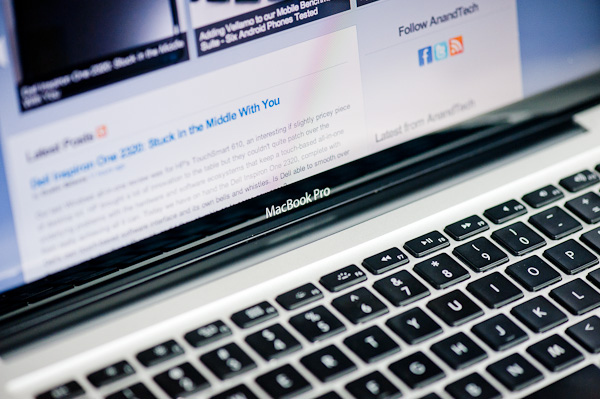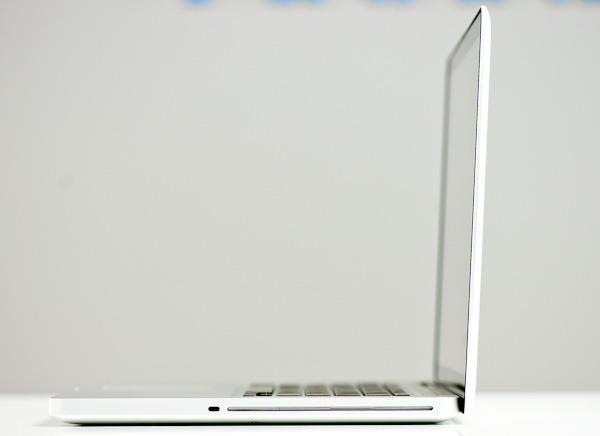Apple 15-inch MacBook Pro (Late 2011) Review
by Anand Lal Shimpi on November 17, 2011 5:10 PM EST- Posted in
- Mac
- Apple
- Intel
- MacBook Pro
- Sandy Bridge
- Laptops
Final Words
While I had a hard time recommending the base 15-inch MacBook Pro to users earlier this year, with the GPU upgrade I'm pretty happy with the $1799 configuration. It is pricey for sure, but if you can only have one Mac in your life and you like performance, it is probably the one to get.
The MacBook Air is nice but for demanding workloads it's not enough. The iMac is fast, but I'm not a fan of lugging around a 27-inch display with me wherever I go. The 15-inch MacBook Pro is honestly the best of both worlds. Obviously there are cheaper PC alternatives if you just need affordable compute, I'm speaking only to those users who have their sights set on something running OS X.
The only changes I'd make to the system are an upgrade in display resolution and the addition of an SSD. Both are options that Apple offers, and with the latter you can always handle that upgrade on your own.
At some point Apple will have to outfit these things with SSDs standard, similar to the MacBook Air. There's such a huge difference in user experience that it only makes sense to, the question is when?
For a while now we've heard rumors of a thinner, redesigned MacBook Pro without an optical drive. Removing the optical drive alone isn't enough to significantly decrease the thickness of the machine, Apple would have to move away from the 2.5" HDD form factor as well. Given that there are no reasonable performing HDDs in a smaller form factor, one would assume that if and when Apple removes the optical drive from the MacBook Pro, it will also remove the hard drive.
Ivy Bridge would be an interesting time to make such a drastic move, as Intel's 22nm process should be able to significantly reduce power consumption. Although the time may be right from a processor perspective, I wonder whether the MacBook Pro audience would be fine with only 128GB or 256GB of storage.
There is of course another option: expand the MacBook Air line with a larger (thicker?) 15-inch model. The trick here would be cramming a 35W quad-core chip into the system, otherwise it just becomes a 13-inch MBA with a bigger screen. That's where the thicker comment comes into play. Currently the MacBook Air only has to worry about dissipating 17W from the CPU, which includes the GPU. The 15-inch MacBook Pro however has a 45W quad-core CPU and a discrete GPU. Ivy Bridge will significantly increase integrated graphics performance, but not enough to truly eliminate the need for a discrete GPU. I suspect for Apple to do the ultra thin 15-inch MacBook Pro the right way it would have to wait until Haswell, where integrated graphics performance is supposed to be much better.
Of course all of this is speculating out loud, anything (or nothing) could happen. If you need a system today, the upgraded MacBook Pro line makes an an already great system a better value. If you can wait, Ivy Bridge will likely be very good for notebook users in about 6 - 8 months.
That's the downside to Intel's tick-tock cadence. When the ticks and tocks are major, there's almost never a good time to buy. Ivy Bridge will significantly reduce power consumption and improve GPU performance and then there's Haswell...
The next two years aren't going to be easy on anyone's wallet.












101 Comments
View All Comments
futurepastnow - Friday, November 18, 2011 - link
And 5400 RPM hard drives standard. Now that's a bad joke.It's also pretty sad that the 13" model still has a 1280x800 screen when Apple's own 13" Macbook air uses a 1440x900 display.
trifecta88 - Friday, November 18, 2011 - link
It could be because current benchmarks are being done on Lion and not Snow Leopardgrahamnp - Friday, November 18, 2011 - link
The 2.2 tested is the replacement for the old 2.0ghz which isn't shown in all the charts but when compared it does come out on top.name99 - Saturday, November 19, 2011 - link
You do realize that the 2.3 GHz model (early 2011) was the EXTREME HIGH END model (best of 2.0, 2.2 and 2.3GHz);the 2.2 GHz model (late 2011) is the LOW END model (worst of 2.2, 2.4 and 25)?
The article could do a better job of explaining that, I'll admit. But you (and even worse, some of the idiotitic followup commentators) could do a better job of not assuming something that is highly unlikely --- that Apple has DELIBERATELY chosen to reduce the performance of its machines, and that Anand is so in love with them that he thought this wasn't worth mentioning.
Better commenters, please.
loox - Sunday, November 20, 2011 - link
Wow... an off-topic, major PC vs Mac fanboy flame war on an Anandtech article re: an Apple product. That *never* happens. *yawn* They both have their place on this planet. Moving on...I'd like to remain on topic *gasp!* and return to the OP's observation:
I am confused, as well... is this a typo in the charts? or is my 15" early 2011 macbook pro really superior to the late 2011 in benchmarks... this is not making sense to me.
On the flipside, if true, it makes me very happy as I purchased the macbook pro for the video card, and am happy to see that I would not have lost much performance gain had I waited for the later 2011 model.
loox - Sunday, November 20, 2011 - link
I am seeing what I think may be the cause...In "early 2011" I purchased the higher end 15" Macbook Pro. At that time, the more expensive model came with the Radeon 6750 and a slightly higher clocked Core i7 SandyBridge (2.3 Ghz). It looks like this model was used in the charts above.
Meanwhile, the model that Anandtech benchmarks in *this* review, is the lower end (cheaper) 15" Macbook Pro which, in "late 2011" has the (1) the same Radeon 6750 GPU as the higher-end, early 2011 Model I have and (2) a slightly slower clocked Core i7 SB CPU (2.2 Ghz).
This explains alot.... had Anandtech tested the 2200 USD variant of the "late 2011" 15" MBP, it surely would have bested my 2200 USD variant of the "early 2011" 15" MBP because it would have benchmarked the higher-end Radeon 6770 and CPU in the 2200 USD MBP.
Basically, it looks like the hardware in my 2200 dollar MBP from early 2011 is now comparable to the hardware in the "late 2011"'s 1800 dollar MBP As a result, I would have waited 2 months had I known I could get pretty much the same hardware for 400 dollars less. But, hindsight is 20/20 and something better always comes along.
This does, however, explain the benchmark tables in this article. Had the higher end variant of the late 2011 MBP been used, the results would no doubt have favored the newer model.
ThreeDee912 - Monday, November 21, 2011 - link
After seeing those charts I knew someone was read it incorrectly and assume Apple is gimping their systems or something....The Early 2011 model is the *high-end* 15" upgraded to the optional built-to-order 2.3 GHz (2820QM) i7 with 8MB L3 cache.
It still ranks slightly higher than the newer model, because the new Late 2011 model in the charts is only the *low-end* stock 15" model with a 2.2 GHz (2675QM) i7 6MB L3 cache.
So the low-end 15" model is quite a bit faster than before, but still not as fast as the highest-end customized 15" model from a few months ago.
To exaggerate, it's like saying "Why is my old i7 still faster than this new Pentium?"
You can see the previous specs here in a neat chart here:
http://en.wikipedia.org/wiki/MacBook_Pro#Technical...
TheGeoff - Thursday, November 17, 2011 - link
It's been awhile since I've gotten to spend any time with this body style. Do they still have that sharp "wrist-cutter" edge on the front? That was a deal killer for me.Brian Klug - Thursday, November 17, 2011 - link
This is actually one of the more subtle things I've noticed with the newer MBPs.After MacBookPro6,2 the front edge on every MBP has received a very small bevel that makes a huge difference on the wrists. I have an 8,2 which has the bevel, so anything newer than 6,2 should likewise have it. It makes the difference between wrist-cutting and not right at the center thumb-notch area too (which used to come to a very sharp point on both sides).
-Brian
retrospooty - Thursday, November 17, 2011 - link
a 15 inch laptop with 1440x900 LCD, 2.2ghz quad core 4gb ram for $1800. I could literally get 2 equivalent ones for that price